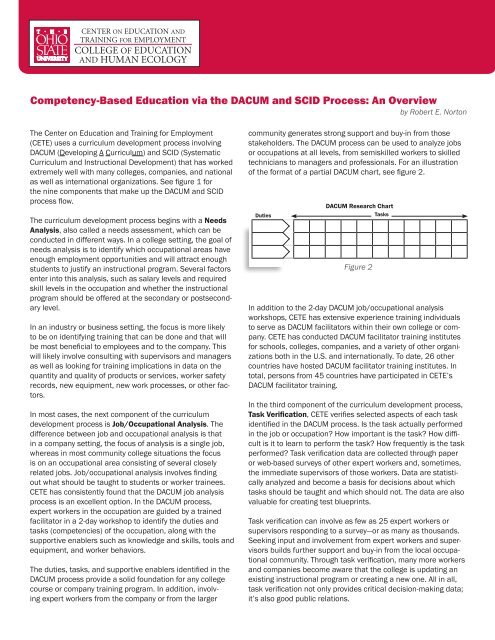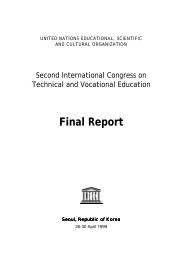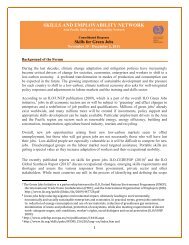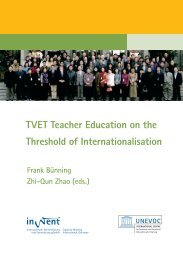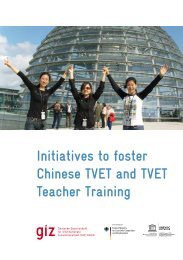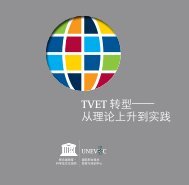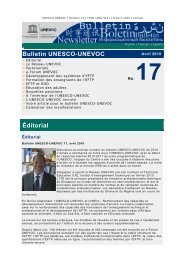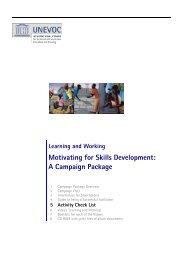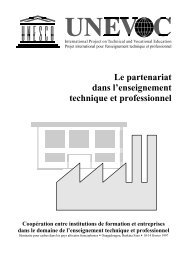Competency-Based Education via the DACUM and SCID Process: An ...
Competency-Based Education via the DACUM and SCID Process: An ...
Competency-Based Education via the DACUM and SCID Process: An ...
Create successful ePaper yourself
Turn your PDF publications into a flip-book with our unique Google optimized e-Paper software.
<strong>Competency</strong>-<strong>Based</strong> <strong>Education</strong> <strong>via</strong> <strong>the</strong> <strong>DACUM</strong> <strong>and</strong> <strong>SCID</strong> <strong>Process</strong>: <strong>An</strong> Overview<br />
by Robert E. Norton<br />
The Center on <strong>Education</strong> <strong>and</strong> Training for Employment<br />
(CETE) uses a curriculum development process involving<br />
<strong>DACUM</strong> (Developing A Curriculum) <strong>and</strong> <strong>SCID</strong> (Systematic<br />
Curriculum <strong>and</strong> Instructional Development) that has worked<br />
extremely well with many colleges, companies, <strong>and</strong> national<br />
as well as international organizations. See figure 1 for<br />
<strong>the</strong> nine components that make up <strong>the</strong> <strong>DACUM</strong> <strong>and</strong> <strong>SCID</strong><br />
process flow.<br />
The curriculum development process begins with a Needs<br />
<strong>An</strong>alysis, also called a needs assessment, which can be<br />
conducted in different ways. In a college setting, <strong>the</strong> goal of<br />
needs analysis is to identify which occupational areas have<br />
enough employment opportunities <strong>and</strong> will attract enough<br />
students to justify an instructional program. Several factors<br />
enter into this analysis, such as salary levels <strong>and</strong> required<br />
skill levels in <strong>the</strong> occupation <strong>and</strong> whe<strong>the</strong>r <strong>the</strong> instructional<br />
program should be offered at <strong>the</strong> secondary or postsecondary<br />
level.<br />
In an industry or business setting, <strong>the</strong> focus is more likely<br />
to be on identifying training that can be done <strong>and</strong> that will<br />
be most beneficial to employees <strong>and</strong> to <strong>the</strong> company. This<br />
will likely involve consulting with supervisors <strong>and</strong> managers<br />
as well as looking for training implications in data on <strong>the</strong><br />
quantity <strong>and</strong> quality of products or services, worker safety<br />
records, new equipment, new work processes, or o<strong>the</strong>r factors.<br />
In most cases, <strong>the</strong> next component of <strong>the</strong> curriculum<br />
development process is Job/Occupational <strong>An</strong>alysis. The<br />
difference between job <strong>and</strong> occupational analysis is that<br />
in a company setting, <strong>the</strong> focus of analysis is a single job,<br />
whereas in most community college situations <strong>the</strong> focus<br />
is on an occupational area consisting of several closely<br />
related jobs. Job/occupational analysis involves finding<br />
out what should be taught to students or worker trainees.<br />
CETE has consistently found that <strong>the</strong> <strong>DACUM</strong> job analysis<br />
process is an excellent option. In <strong>the</strong> <strong>DACUM</strong> process,<br />
expert workers in <strong>the</strong> occupation are guided by a trained<br />
facilitator in a 2-day workshop to identify <strong>the</strong> duties <strong>and</strong><br />
tasks (competencies) of <strong>the</strong> occupation, along with <strong>the</strong><br />
supportive enablers such as knowledge <strong>and</strong> skills, tools <strong>and</strong><br />
equipment, <strong>and</strong> worker behaviors.<br />
The duties, tasks, <strong>and</strong> supportive enablers identified in <strong>the</strong><br />
<strong>DACUM</strong> process provide a solid foundation for any college<br />
course or company training program. In addition, involving<br />
expert workers from <strong>the</strong> company or from <strong>the</strong> larger<br />
community generates strong support <strong>and</strong> buy-in from those<br />
stakeholders. The <strong>DACUM</strong> process can be used to analyze jobs<br />
or occupations at all levels, from semiskilled workers to skilled<br />
technicians to managers <strong>and</strong> professionals. For an illustration<br />
of <strong>the</strong> format of a partial <strong>DACUM</strong> chart, see figure 2.<br />
Duties<br />
<strong>DACUM</strong> Research Chart<br />
Tasks<br />
Figure 2<br />
In addition to <strong>the</strong> 2-day <strong>DACUM</strong> job/occupational analysis<br />
workshops, CETE has extensive experience training individuals<br />
to serve as <strong>DACUM</strong> facilitators within <strong>the</strong>ir own college or company.<br />
CETE has conducted <strong>DACUM</strong> facilitator training institutes<br />
for schools, colleges, companies, <strong>and</strong> a variety of o<strong>the</strong>r organizations<br />
both in <strong>the</strong> U.S. <strong>and</strong> internationally. To date, 26 o<strong>the</strong>r<br />
countries have hosted <strong>DACUM</strong> facilitator training institutes. In<br />
total, persons from 45 countries have participated in CETE’s<br />
<strong>DACUM</strong> facilitator training.<br />
In <strong>the</strong> third component of <strong>the</strong> curriculum development process,<br />
Task Verification, CETE verifies selected aspects of each task<br />
identified in <strong>the</strong> <strong>DACUM</strong> process. Is <strong>the</strong> task actually performed<br />
in <strong>the</strong> job or occupation? How important is <strong>the</strong> task? How difficult<br />
is it to learn to perform <strong>the</strong> task? How frequently is <strong>the</strong> task<br />
performed? Task verification data are collected through paper<br />
or web-based surveys of o<strong>the</strong>r expert workers <strong>and</strong>, sometimes,<br />
<strong>the</strong> immediate supervisors of those workers. Data are statistically<br />
analyzed <strong>and</strong> become a basis for decisions about which<br />
tasks should be taught <strong>and</strong> which should not. The data are also<br />
valuable for creating test blueprints.<br />
Task verification can involve as few as 25 expert workers or<br />
supervisors responding to a survey—or as many as thous<strong>and</strong>s.<br />
Seeking input <strong>and</strong> involvement from expert workers <strong>and</strong> supervisors<br />
builds fur<strong>the</strong>r support <strong>and</strong> buy-in from <strong>the</strong> local occupational<br />
community. Through task verification, many more workers<br />
<strong>and</strong> companies become aware that <strong>the</strong> college is updating an<br />
existing instructional program or creating a new one. All in all,<br />
task verification not only provides critical decision-making data;<br />
it’s also good public relations.
Figure 1
In <strong>the</strong> next component of <strong>the</strong> curriculum development process,<br />
Task Selection, data ga<strong>the</strong>red during task verification<br />
are used to select tasks for instruction. Instruction would<br />
typically not be provided for a task that is of low importance<br />
or of low difficulty or that is performed by very few workers<br />
unless <strong>the</strong>re is a compelling reason to provide instruction—for<br />
example, <strong>the</strong> task is a new one that workers have not yet been<br />
trained to perform. CETE’s experience has been that if a task<br />
is performed by fewer than 25 percent of workers, it should<br />
be set aside, as <strong>the</strong> return on investment for training on such<br />
a task will be quite low. Usually, task selection decisions<br />
should be made by a team of qualified persons; in a college,<br />
for example, a team could include <strong>the</strong> department chair, an instructor,<br />
a curriculum specialist, <strong>and</strong> a member of <strong>the</strong> <strong>DACUM</strong><br />
panel.<br />
The next component of <strong>the</strong> curriculum development process is<br />
to conduct Task <strong>An</strong>alysis. Whe<strong>the</strong>r in a college or a company,<br />
instructors need more information (unless <strong>the</strong>y have had<br />
recent personal experience) on <strong>the</strong> tasks selected for instruction:<br />
<strong>the</strong> steps of <strong>the</strong> task, <strong>the</strong> tools <strong>and</strong> equipment needed,<br />
<strong>the</strong> knowledge <strong>and</strong> skills required, safety concerns, relevant<br />
worker behaviors, decisions <strong>the</strong> worker must make, <strong>and</strong> <strong>the</strong><br />
criteria used by industry to judge <strong>the</strong> adequacy of performance.<br />
CETE recommends that ideally, all tasks should be analyzed.<br />
However, <strong>the</strong>re may be limitations to task analysis in practice.<br />
Companies usually want every important task analyzed.<br />
Company managers often say that <strong>the</strong>y want to capture <strong>the</strong><br />
intellectual capital of current workers before <strong>the</strong>y leave or<br />
retire. Colleges, on <strong>the</strong> o<strong>the</strong>r h<strong>and</strong>, often feel that instructors<br />
are responsible for personally conducting task analysis or for<br />
bringing in guest speakers on tasks <strong>the</strong>y are not familiar with.<br />
A thorough analysis of a single task with many steps can take<br />
an hour or more, so limited availability of expert workers from<br />
industry <strong>and</strong> limited time available to instructors can make<br />
task analysis difficult.<br />
Next, an instructional <strong>Competency</strong> Profile is established using<br />
good professional judgment. CETE recommends examining<br />
<strong>the</strong> results of task analysis carefully to see which tasks<br />
require similar knowledge <strong>and</strong> worker behaviors. Often, <strong>the</strong>re<br />
are multiple tasks in <strong>the</strong> occupation that require basically <strong>the</strong><br />
same knowledge, although <strong>the</strong> knowledge may be applied<br />
differently. For instruction, it often makes a lot of sense to<br />
cluster such tasks toge<strong>the</strong>r <strong>and</strong> write a new competency statement<br />
that encompasses all of <strong>the</strong> clustered tasks.<br />
CETE likes to point out that not all tasks are of <strong>the</strong> same size<br />
or importance; some tasks are so significant that <strong>the</strong>y deserve<br />
to be an instructional competency all by <strong>the</strong>mselves. In<br />
many cases, however, if like tasks are clustered into a single<br />
competency, students or employees do not have to read <strong>the</strong><br />
same information two or three times—or more. The necessary<br />
information can be supplied once in a single learning guide or<br />
module, <strong>and</strong> learners can spend time practicing <strong>and</strong> demonstrating<br />
<strong>the</strong> skills involved.<br />
With task analysis completed <strong>and</strong> detailed, step-by-step<br />
information ga<strong>the</strong>red, competency-based Curriculum Materials<br />
can now be developed. Many types of competency-based<br />
materials can be developed, including learner-centered<br />
learning guides, learning aids, h<strong>and</strong>books, h<strong>and</strong>outs, <strong>and</strong> job<br />
aids or instructor lesson plans—to mention just a few. Time,<br />
resources, instructor preferences, <strong>and</strong> institutional preferences<br />
are some of <strong>the</strong> factors that determine which materials are<br />
developed. Most of <strong>the</strong> trainees CETE has worked with prefer<br />
to develop learning guides designed for learners to use at<br />
<strong>the</strong>ir own pace. CETE feels that although learning guides take<br />
skill <strong>and</strong> time to develop, <strong>the</strong>y have many advantages.<br />
Learning guides consist of a performance objective <strong>and</strong> two<br />
or more enabling objectives. For each enabling objective, a<br />
learning experience with multiple, carefully selected activities<br />
is developed. Each learning experience contains a Self-Check<br />
<strong>and</strong> Model <strong>An</strong>swers <strong>and</strong>/or a Practice Exercise. Upon completion<br />
of all learning experiences, <strong>the</strong> learner must demonstrate<br />
his or her skill; <strong>the</strong> instructor uses <strong>the</strong> performance criteria<br />
in <strong>the</strong> learning guide’s Performance Test to evaluate <strong>the</strong><br />
learner’s performance. If <strong>the</strong> learner does not demonstrate<br />
competency in <strong>the</strong> Performance Test, <strong>the</strong> instructor guides<br />
him or her to more practice or o<strong>the</strong>r activities until competency<br />
is achieved. A knowledge test may also be administered,<br />
if desired.<br />
Once competency-based curriculum materials have been<br />
developed, it’s time to Begin Training—assuming you’ve<br />
recruited students, provided <strong>the</strong> necessary facilities, hired a<br />
qualified instructor, <strong>and</strong> so on. The instructor has three very<br />
important roles: advise students, assist students, <strong>and</strong> assess<br />
student progress. Instruction may be delivered in a classroom,<br />
in a laboratory, online, or through on-<strong>the</strong> job training. Often,<br />
instruction is delivered in a blended approach using two or<br />
three different methods.<br />
Administrators, o<strong>the</strong>r stakeholders, <strong>and</strong> learners may need<br />
to be oriented to learning guides or modules if <strong>the</strong>y are being<br />
used for <strong>the</strong> first time. It may be a challenge for instructors<br />
to develop high-quality, learner-centered, competency-based<br />
materials, but CETE has identified many advantages of learning<br />
guides:<br />
• They allow learners to work at <strong>the</strong>ir own pace.<br />
• They free <strong>the</strong> instructor from lesson planning <strong>and</strong><br />
lecturing.
• The instructor or trainer becomes a facilitator of learning.<br />
• Instructional content is st<strong>and</strong>ardized for all students.<br />
• The instructor has more time to work with individuals <strong>and</strong><br />
small groups of students.<br />
• The learner always has an opportunity to practice <strong>the</strong> skill<br />
before demonstrating that he or she has achieved <strong>the</strong><br />
competency.<br />
The last component of <strong>the</strong> curriculum development process,<br />
<strong>Competency</strong> <strong>and</strong> Program Assessment, is often given only<br />
minimal attention but is essential to <strong>the</strong> assessment of program<br />
outcomes <strong>and</strong> to program improvement. A Performance<br />
Test at <strong>the</strong> end of each learning guide assesses <strong>the</strong> learner’s<br />
skill in <strong>the</strong> tasks covered by that learning guide. In overall<br />
competency assessment, however, <strong>the</strong> learner’s skill is assessed<br />
across many competencies for many purposes such as<br />
course grading, worker promotion, worker performance, certification,<br />
<strong>and</strong> credentialing. It is important to note here that <strong>the</strong><br />
<strong>DACUM</strong> analysis coupled with task analysis <strong>and</strong> task verification<br />
can provide a legally defensible basis for higher stakes<br />
competency assessments used in certification or employment<br />
situations.<br />
During <strong>the</strong> course of instruction, program formative evaluation<br />
data should also be collected on how well <strong>the</strong> instructional<br />
program is working. If some elements of <strong>the</strong> program are<br />
not working well, in-course corrections should be made as<br />
soon as possible. At <strong>the</strong> end of each cycle of <strong>the</strong> instructional<br />
program, summative evaluation should also determine learner<br />
completion rates, learner satisfaction, instructor reactions,<br />
cost per student, <strong>and</strong> o<strong>the</strong>r data that can indicate needed<br />
program improvements <strong>and</strong> provide for program accountability.<br />
For questions about <strong>DACUM</strong> or <strong>SCID</strong>, contact Bob Norton<br />
at norton.1@osu.edu or 614/292-8481; or John Moser at<br />
moser.120@osu.edu or 614/247-7989.<br />
References<br />
Norton, R. E., & Moser, J. (2008). <strong>DACUM</strong> h<strong>and</strong>book (3rd<br />
ed.). Columbus, OH: Center on <strong>Education</strong> <strong>and</strong> Training for<br />
Employment, The Ohio State University.<br />
Norton, R. E., & Moser, J. (2007). <strong>SCID</strong> h<strong>and</strong>book (7th ed.).<br />
Columbus, OH: Center on <strong>Education</strong> <strong>and</strong> Training for<br />
Employment, The Ohio State University.


